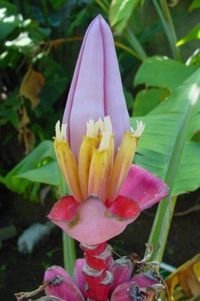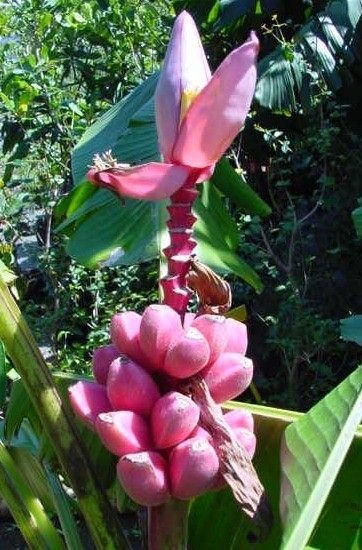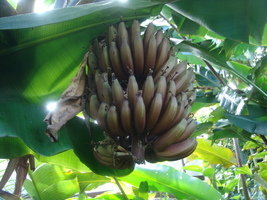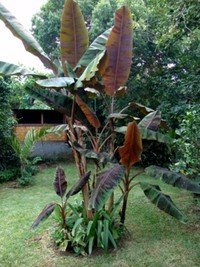





According to official sources each French person consumes annually some 9.6kg of bananas, the most marketed fruit in the world. But although many are familiar with this fantastic fruit, easy to peel and eat, with curved outlines seemingly designed for a perfect fitting in the hand, few know what is behind this common cover. We will therefore take a peep backstage.
First of all let us make one point clear: bananas do not grow on trees because banana trees are not trees...(yes, you can read this a second time to make sure). A tree is a wooden plant while banana (so called) trees are herbaceous plants growing from a perennial stock and made of encased sheaths, it is thus a giant herb which may reach ten meters (thirty feet) high with leaves up to two or three meters, not your usual lawn grass. Each shoot will grow into a pseudo-trunk, produce flowers and fruits then die and allow another shoot to go through the same process.
Each cycle will take less than a year to complete from young shoot to bunch weighting between 15 and 70 kg, depending on the variety. Let us remind ourselves that bananas, just like pineapples, are parthenocarpic fruits which means that there is the growth of ovaries into fruits without previous fecundation and they therefore lack seeds (aspermous). So it is useless to toss a banana in a flower pot and hope it will become a plant, propagation is always done by propagation. Well, there ARE seeded bananas but those are ornamental species (Musa coccinea or Musa velutina) or wild ones, which would be only enjoyed by monkeys and insects.
Regarding the geographical birthplace of the plant, it is set in a large part of Southeast Asia comprising Malaysia, Indonesia, Philippines and Burma. Botanically speaking the edible bananas (Musa x paradisiaca) is an hybrid between Musa acuminata and Musa balbisiana, the triploid (three chromosome chains). There are also diploids and tetraploids ones, actually the bananas classification is so complex than taxonomists themselves decided to only work on diploids. Anyway, next time you want to go and buy your favorite desert do not order a pound of ‘aspermous triploids' as the guy behind the counter may take it as a personal insult...
Now the technical part. In the field there are basically two ways of growing the plant, either one-bearer (one bunch per clump) or several (hence several bunches per clump). Actually the main job consists in dealing correctly with the clumps by removing the unwanted shoots and selecting the ones to be kept in order to keep a clean clump and have all clumps growing in the same direction (a banana clump will move forward following the direction of the initial side shoot). A sharp eye will easily distinguish between a shoot with narrow leaves able to nourish the clump and a ‘cabbage leaves shot' which tries to free itself and weaken the clump. The setting of the first shoot has to be carefully undertaken as it has to be correctly oriented in order to produce a clump growing in a determined way and not a fussy thing growing in all directions. As with all technical languages banana shoots bear different names according to their aspect and height but although I tried to get the English names I failed and will then just give the French ones; a small young shoot is called a ‘pistolet' (pistol), a larger one is a ‘baïonnette' (bayonet) and an even larger one is a ‘demoiselle' (young lady) but do not ask me why...
The average planting density is of 2000 plants per hectare (10000 square meters) which will produce between 30 and 60 tons of fruits depending on the variety grown, the local climate and the growing methods; the 'Cavendish' variety allows to harvest 100 tons per hectare. This plant will do better in loose soils with high levels of nitrogen and potassium and will need some 1200 to 1500 mm of rain per year. There are some 500 different edible bananas recorded, from the very classical yellow "Chiquita" grown all over Latin America to plantain bananas, the ones to be cooked which are the basis for carbohydrates intake in many parts of Africa. You can also find red fruits, pink, black (yes they do exist), striped ('Koae' and 'Vittata' from Pacific islands), apple-banana, rhino horn, 'Dwarf Cavendish'mah, Mahoi, Fehi and so on. Truly, bananas do offer a rather large choice of tastes and texture although most European and U.S. consumers mostly eat sweet but insipid fruits while in countries where they are grown one can find much tastier ones. Some are just strange like the ‘Pisang seribu' from Malaysia which bunches can be a long as three meters with fruits the size of a small finger (another one of its names is "thousand fingers.") Bananas are eaten fresh or can be dried, turned into jelly and juices and of course cooked for the plantain kinds. In some parts of India, banana trees are grown only for harvesting the leaves which are used on markets to wrap food or as plates in traditional restaurants.
So all in all, bananas are much more sophisticated and fascinating than what most people think, the poor yellow thing in your supermarket in the only the visible part of a delicious iceberg which deserves more attention!
Copyright © www.100flowers.win Botanic Garden All Rights Reserved